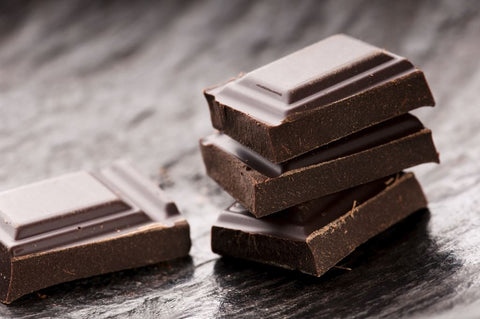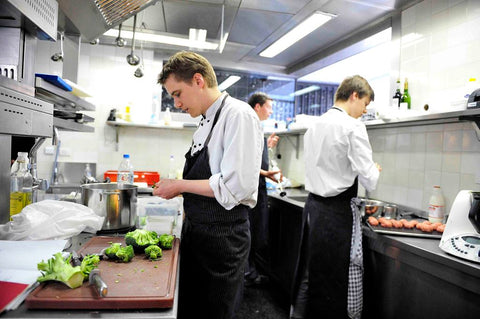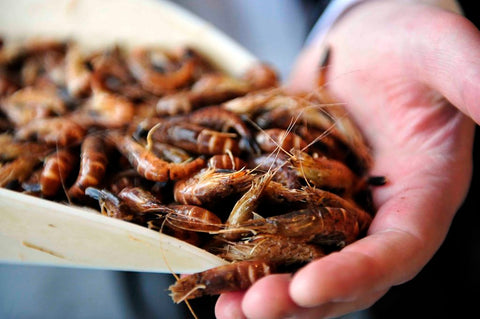- No products in the cart.
Typical Dishes
This is your basic guide to contemporary day-to-day Belgian cuisine. Not every dish here is 100% authentic but they all are an indispensable part of Belgium’s culinary culture.
You’ll find them served at many local restaurants, bistros and brasseries. A couple of them are even listed on our beer recipe page.
Asparagus, Flemish Style

- Beer Pairing Tips: Duvel Moortgat / Morpheus Tripel Alvinne / La Corne Blond
White Asparagus, and particularly that grown around the asparagus capital of Mechelen, is considered a luxurious delicacy. It’s softer and sweeter than the more usual green variety and the Mechelen locals call it white gold. When it’s in season, from the end of April to the 24th of June, there really is no escaping it and you’ll find asparagus on every menu in starters, main courses and even desserts.
The traditional and authentic way to serve Belgian asparagus is Flemish Style: boiled or steamed to perfection and served with chopped hardboiled eggs, parsley and a clarified butter sauce. It’s terribly simple but unbelievably rich and tasty.
As all of Belgium and certainly Flanders is asparagus mad you’ll find it in everything from pates and quiches to ice cream.
Typical variations on the basic Flemish Style recipe include the addition of smoked salmon, ham, hollandaise sauce, grey shrimp, poached eggs or, for the ultimate in luxury, truffle.
Croquettes

- Beer Pairing Tips: Witheer Scheldebrouwerij / Brugs Tarwebier / St. Bernardus Wit
Belgium adores croquettes and these are completely different from the potato filled variety served as a simple side dish. The two most popular traditional Belgian croquettes have a thick and creamy cheese or grey shrimp filling. Most menus offer both either as a starter or a main course.
You’ll find croquettes served almost everywhere in Belgium and the quality comes down to the filling. As a main dish they are usually served with a salad, fried parsley and frites.
More adventurous chefs have experimented with the classic formula, adding endives, asparagus, goat’s cheese or beer to their fillings.
Croque (Grilled Sandwich)

- Beer Pairing Tips: Troubadour Blond / Belgoo Magus / Harlekijn
The croque-monsieur is, of course, as French as garlic bread and snails and has appeared on Parisian menus since the early 1900s. But Belgium lovingly embraced this simple dish and made it its own.
Abbey cheese, grey shrimp, foie gras, crab, lobster, a vol-au-vent style sandwich with puff pastry instead of bread - the possibilities of this culinary classic are limitless.
Don’t expect glamour and surprises everywhere though, the classic ham-cheese combination - with or without the fried egg that makes a croque monsieur a croque-madame - is still the most commonly served.
It’s a great snack, especially when you need something hot and fast and can’t face any more fries.
Eel (Paling / Anguilles)

- Beer Pairing Tips: Belgoo Luppo / Orval / Saison Dupont
Fresh or smoked, Flanders is one of many countries which regards eel as a delicacy. They’re commonly served pan fried, in a cream sauce or Provençale. As with mussels you’ll find restaurants specialised in serving eels, usually with frites or bread.
Paling in t’groen, or eels in a (very) green sauce is, however, the classic Belgian eel dish. It’s made with a selection of fresh green herbs which may include chervil, sorrel, parsley, pimpernel, watercress, basil, chives and thyme.
Chervil and sorrel are the key ingredients though and these are added right at the end of the cooking process to give the dish its vibrant green, fresh finish.
The dish is thought to originate from the Scheldt river bank, where fishermen would prepare their eels with any herb to hand.
Filet Américain (Steak Tartare)
_1024x683.jpg?1393613361)
- Beer Pairing Tips: Strubbe Pils / Bockor Pils / Bavik Pils
Belgians know that this raw national favourite sounds appalling to some outsiders. When served on toast they even affectionately call it “Toast Cannibal”. Nevertheless, it is eaten and enjoyed by many.
Many restaurants prepare the dish at the diner’s table so it’s served just as you like it. Raw beef is the basis of Steak Tartare but you’re getting much more than that.
Some popular seasonings include: raw onions and shallots, pickled onions, egg yolks, Worcestershire sauce, Tabasco, mayonnaise, mustard, ketchup, fresh or pickled capers, salt, pepper, oil, parsley and baby pickles.
Fish Soup

- Beer Pairing Tips: Gouden Carolus Classic / Moinette Brune / Wieze Tripel
This is a long way from the French classic Bouillabaisse. Yes, it’s a fish soup, but the preparation gives it a distinctly northern European flavour. In Belgium, fish soup means: fish stock, white wine, saffron, tomatoes, onions and leeks, with fresh North Sea sea food and a whole host of herbs and spices.
It’s a favourite all along the coast. You might see it named after Belgian fishing ports as Ostend or even North Sea Bouillabaisse.
Flamiche

The citizens of Dinant love their flamiche: a type of savoury tart prepared using Boulette de Romedenne or a similar, slightly salted regional cheese with a high fat content. They used to be baked in a wood oven and the tiny flames – flammèches – that the charcoal produced may have given rise to the name.
No-one knows the exact origins of this dish. The legend has it that a farmer’s wife is responsible. She was walking down the rue Saint Jacques on her way to market when she slipped on an icy patch and broke all the eggs she was carrying.
A quick-thinking baker managed to catch the broken eggs, added cheese and butter and baked the lot on a base of bread dough.
How do you prepare a good flamiche? First, seek out a Boulette de Romedenne cheese, preferable one that has matured for 14 days.
The cheese has to be runny, pale yellow in colour, and free of the ammonia scent that is often found in badly wrapped or over-chilled cheeses of the brie type. The flamiche symbolises the rich Burgundian way of life that can be enjoyed on the banks of the Meuse: real butter, eggs and cheese….
And what’s more, a good Burgundy wine to accompany this dish. The Confrérie de la Flamiche (the Brotherhood of the Flamiche) organises an annual flamiche eating competition.
The winner simply eats as much flamiche as possible as quickly as possible. The festivities take place in September. Flamiche is a well-kept secret though and unknown even to most Belgians, Flemish or Walloon. If you want to try it, check with the baker or restaurant first that they have the city’s pride available.
Flemish Carbonades

- Beer Pairing Tips: Troubadour Obscura / Keyte Dobbel Tripel / St. Bernardus 12
This is the quintessential Belgian beer dish and it’s the one that visitors always end up talking about. The easiest way to describe it is beer braised beef stew or, in British terms steak and ale… but please don’t if you don’t want to offend the locals.
The devotion to stoofvlees borders on the religious in Belgium. There are as many different ways to prepare it as there are people cooking it and whatever your hosts might claim there’s no definitive formula.
However, these are generally considered essential ingredients: onions, beef, dark beer, salt, pepper, a slice of bread, mustard and a wide selection of herbs and spices. Among the extras added to this basic recipe are carrots, mushrooms, bacon, red wine, shallots, chocolate, gingerbread and preserves.
In fact, the discussion over added extras is as heated as the debate over which beers make for a good stoofvlees. It’s a hearty, warming dish, usually served with frites and salad or green vegetables. If you’re coming to Belgium you really ought to try it and for a really authentic night out wash it down with the same brew that’s in your gravy.
Game

- Beer Pairing Tips: Ichtegemse Grand Cru, brouwerij Strubbe / Rodenbach Vintage 2009
Today a lot of game like deer is farmed and so it’s available all year round, but traditionally the Belgian hunting season runs from October till the end of January or the beginning of February. Then restaurants stuff their menus with an array of specialities featuring hare, venison, wild boar, pheasant, partridge or duck.
While game is widely available and very popular in Belgium it’s particularly associated with the deep forests of the Ardennes where most of the deer and wild boar are bagged.
When in season, game is used in everything, from simple soups and rural dishes to more refined cuisine.
A favourite of Belgian game cooking is Pheasant à la Brabançonne, a rich casserole of the bird with endives or chicory and bacon. The Brabançonne also happens to be the title of the national anthem.
Gentse Waterzooi

- Beer Pairing Tips: Malheur 8 / Gentse Strop / Geuze Cantillon
Although named for the city of Ghent, where it originated, there’s no simple way to translate the name of this soup-like stew. However, the old Flemish word zooien means to boil and that gives you some idea of what’s going on here.
It’s based on a vegetable stock which is thickened with egg yolks and cream before leeks, onions, carrots, potatoes, celery and seasoning are added.
Historically waterzooi was a fresh water fish dish, but these days you’re more likely to find it being made with chicken.
Rumour has it that the rivers around Ghent got so polluted that the fish died out. Whatever the reason, this traditional dish remains an undisputed classic of Flemish cuisine.
Ham & Endive Gratin

- Beer Pairing Tips: Witloofbier Hof ter Dormaal / Ename Tripel / Zeezuiper
This dish epitomises rural Belgian cooking. It’s a true classic of the nation’s cuisine and should ideally be made with just domestic ingredients - endives or chicory, a regional cheese and prime boiled ham.
As the bitterness of the endives isn’t to everyone’s taste, you’ll find other green vegetables used as a substitute and some cooks add beer to their cheese sauce.
Perhaps to prevent people having frites with everything this gratin traditionally gets served with mashed potatoes. This is a dish for the hearth and home and you’re unlikely to see it on many restaurant menus.
Hutsepot

- Beer Pairing Tips: Wolf 8 / Geuze Cuvee Renee / Slaapmutske Bruin
Hodgepodge (hotchpot) of different vegetables and cuts of meat, heartier and less sophisticated than Ghent Waterzooi. It’s farmer’s food and you’ll find it appearing on menus as the winter starts to draw in.
A typical hutspot will feature either pork or beef – in the form of sausages, ribs or chops – stewed with vegetables including Savoy cabbage, turnips, potatoes, carrots and Brussels sprouts.
Pig’s feet, ears, tail or marrow can also be added. Like many Belgian dishes, each region – and even each family or chef – has put their own personal stamp on their version of this classic.
Don’t worry if you’re served ears, trotters or tail, it’s not an insult and these cheap cuts are there to beef (or pork) up the broth.
Meat Balls in Tomato Sauce (Boulettes)

- Beer Pairing Tips: St. Bernardus Tripel / Dulle Griet / La Chouffe
It might sound Italian, but boulettes are a great staple of Belgian home cooking and should be prepared as simply and honestly as possible. The ingredients? Minced pork and beef, onions, mushrooms, a great homemade tomato sauce and a lot of fresh herbs.
Again, there are plenty of variations on the theme. Some people add beer and around Liège you’ll find the local pear syrup used in the sauce, giving a distinctive sweet taste. The Flemish use cherries.
Your plate of boulettes will usually come with mashed potatoes or frites.
Moules Frites

- Beer Pairing Tips: Belgoo Magus / Strandgaper / Malheur 10
When you think of Belgian cuisine this is probably what you think of and moules frites is nothing less than a national icon. They are so popular with Belgians you’ll have no trouble finding restaurants serving nothing but mussels and chips prepared in fifteen or more different ways.
Ironically the mussels themselves are actually Dutch and farmed these days as the wild Belgian variety are no longer good or abundant enough to meet demand. The mussel season runs from the second half of July until April. Each year Belgium devours about 30 million tons of Dutch mussels, that’s 3 kg per person and almost half of the Netherlands total output.
Mussels served outside the Dutch season usually come from Denmark and sadly aren’t considered up to scratch. With such demand it’s no surprise that attempts to farm mussels off the Belgian coast are underway, with varied degrees of success. They’re branded as Belgica mussel and are mostly sold to restaurants. Wheat beer goes brilliantly with mussels both as an accompaniment and a complimentary ingredient.
Potjesvlees & Hennepot

Potjesvlees is a dish typical of the Westhoek: the area surrounding Ypres and Poperinge. Potjesvlees is made with chicken, boiled and diced rabbit and veal and herbs. It is served covered in a gelatinous sauce with a touch of acid coming from lemon, white wine or vinegar.
Several butchers from the Westhoek region have united under the banner of the Orde van het Potjesvlees and this dish is now a recognised regional product in Belgium.
The group now harbour European ambitions. In co-operation with colleagues from northern France, who also make the stew, they intend to apply to have potjesvlees recognised and protected by the EU. Hennepot is another traditional, regional dish of Westhoek, made with chicken, rabbit and veal. Traditionally, the meats were roasted together before being baked in an earthenware pot, usually alongside the family bread, bubbling away as the loaves rose in the oven.
Hennepot is eaten cold, covered in a gelatinous sauce made with lemon juice and white wine, usually accompanied by a salad.





